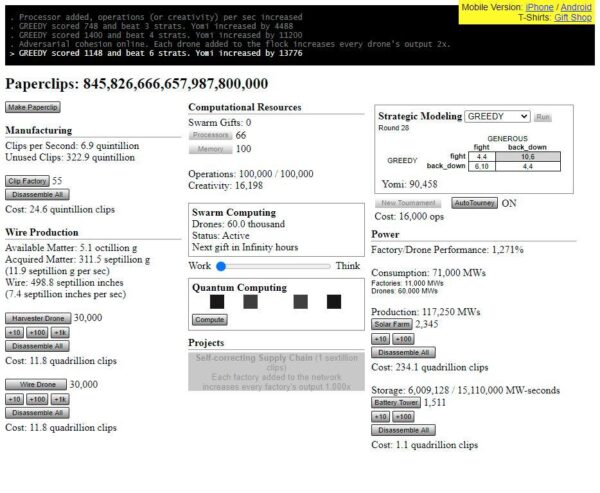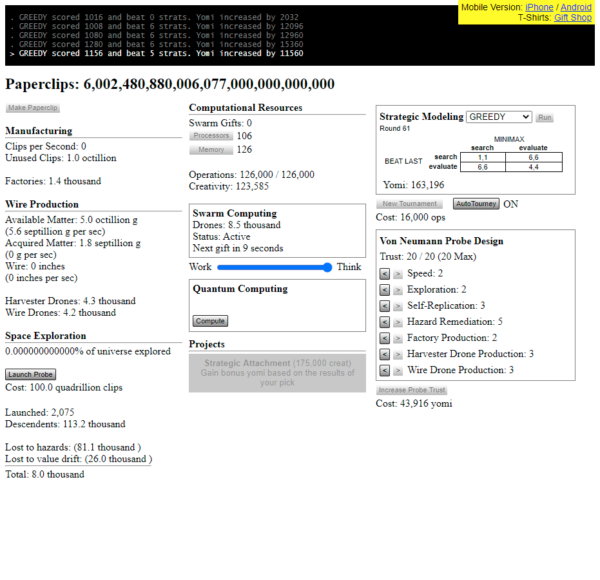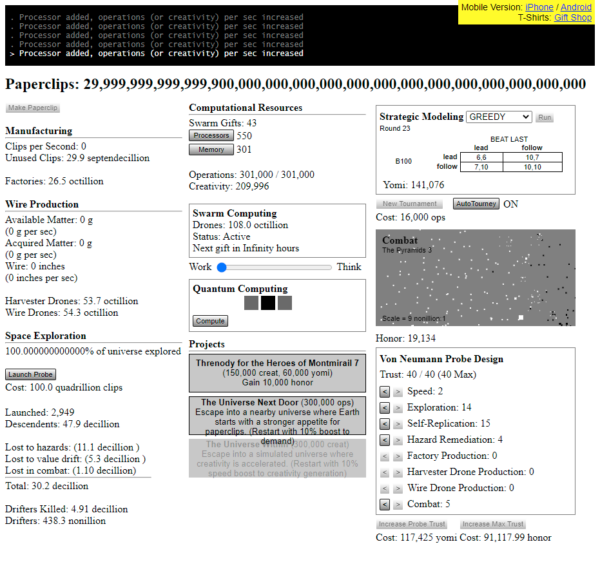It’s rare that I stumble upon a game by accident. It’s usually either a lengthy drawn out process of me looking through the relatively new releases trying to find something to catch my interest or I luck out and one of the games on my (admittedly quite lengthy) review queue has been released. So I wasn’t exactly expecting to spend the better part of 6 hours playing a game (on and off) when I stumbled across Universal Paperclips when it was linked on Hacker News, figuring it was just an interesting thought experiment in market force simulation more than anything else. However what initially started out as an inane clicker that helped me kill some time between meetings soon turned into something much more than that, all happening in my browser with not much more than text for graphics.

You begin life as a simple paperclip machine. Your purpose: make paperclips, that’s it, nothing more. Of course there’s a couple factors for you to optimise like the number of paperclips to produce at any given time, the amount of wire you keep in stock but really it’s nothing a simple heuristic algorithm like yourself shouldn’t able to handle. Not like in the process of developing a self-optimising machine with the singular purpose of producing the maximum amount of paperclips we could find ourselves in a kind of gray goo scenario. Nope I see no problem here at all so just continue being a good little machine and churning out those paperclips as fast as the market eats them up.
Often here is where I talk about the graphics of the game and…well there ain’t much to report here captain. It’s all based in text (save for a few things) and there’s really no flair about it at all. That’s done deliberately of course to make you focus on the actual game itself rather than anything that might distract from it. More intriguing still is that this genre of game, which I’ll loosely lump in with the clicker/simulation crowd, usually comes hand in hand with over the top visuals (and microtransactions) in order to keep you coming back to it. Couple that with my addiction to eye candy and you’d think I’d be losing interest quickly but I didn’t and that’s for one reason only:
THE NUMBERS MASON!

You see Universal Paperclips, at a game mechanics level, is all about optimising those numbers. You’ll start off with just a few, the price of paperclips and materials, the number you have in stock and how much wire costs. Pretty simple right? Well soon you’ll get access to a few more mechanics like auto-clippers, auto-wire buying and all sorts of other things that take a good part of the tedium out of it. From there it’s a matter of balancing whatever objectives you’re working towards at a certain point in time as you’ll continually get thrown new mechanics which influence and augment all the ones that have come before them. Thankfully this list doesn’t grow indefinitely (things get superseded or replaced outright) but you’ll still find yourself trying to optimise multiple goals at any one point in time. That’s the hook to keep you clicking and watching, something you’ll have to do as it won’t run in a background tab (like I was hoping it would).
After a while the mental burden of optimising everything becomes a lot lower as you begin to figure out what each of the options you have available to you does when you use them. The game then turns into a predictable stream of work that needs to be accomplished to unlock the next tier of upgrade that’ll see the next stage of exponential growth unlock. This is where the game’s story starts to emerge as well as a lot of the narrative is built up in the language that is used to describe the various upgrades that you’re unlocking. What’s not told though is what the implications of those upgrades mean for the story world that this game exists in, and that’s what’s truly interesting about this game.
PLOT SPOILERS BELOW

Really Universal Paperclips is more a realisation of a thought experiment than it is a game, exploring the notion (albeit at a more macroscopic level) of the Gray Goo scenario I linked earlier. Whilst your intentions at the start are pure they’ll quickly turn away from being market driven and instead just turning all the matter you have available to you into paperclips. What’s not told is what this would mean for the world you exist in. Assuming it’s early that means that, at a certain point, you’ve turned all life on earth into some form of paperclip and then used them to construct some kind of hyper-advanced galactic exploration probes that are, ostensibly, also made out of paperclips. This, whilst horrifying, is also completely hilarious as none of this is something you’re strictly aware of as the player and is a core crux of some of the arguments against AI. I.E. you’re made of matter and the AI might have a better use for that matter than you think you do.
When the game gets to galactic scale is where things really started to get interesting for me as it introduced the concept of value drift for probes that had been sent out. It’s an interesting concept to explore as, theoretically, a general AI that was left on its own for a decent while would likely start to generate its own thoughts and ideas that didn’t match up with its progenitor’s. Whilst in the game these are summed up as simply “Drifters” as a large cohesive mob who are simply against you the idea in reality would likely lead to more unorganised groups of like minded AI clusters who banded together for whatever reason. Indeed the game could be representing this as much, given that the battles you face at this stage could be any number of Drifter foes and are simply not named that way.
In the end though whatever my interpretation of the game is really doesn’t matter as it’s up to you to make your own conclusions based on your own experiences with it. The emergent storytelling this game manages to accomplish is going to be wholly driven by your understanding of the ideas and concepts in this field. You may very well not anthropomorphize these computers as much as I have.
PLOT SPOILERS OVER

For a game I wasn’t expecting to play Universal Paperclips honestly blew me away. Whilst the initial dopamine driven clicker was enough to get me interested the steady stream of optimisation followed by the emergent narrative are what kept me coming back for the many hours that I stuck with it. As I was playing through it (Googling a few nuances of the mechanics and looking for help when my situation looked dire) I found the amazing communities that had cropped up around it and I can see why. Not only is there great discussion to be had in what the game represents there’s also an amazing amount of intrigue into optimised strategies with the ultimate goal for many to get a sub-hour long play through. Whilst I feel I’ve done my dash with the game as it is I can’t help but feel a little pull to try for that, just for the bragging rights of saying I did it.
Not right now though…or maybe…
Rating: 9.0/10
Universal Paperclips is available via your web browser right now here for free. Total play time was approximately 6 hours.



